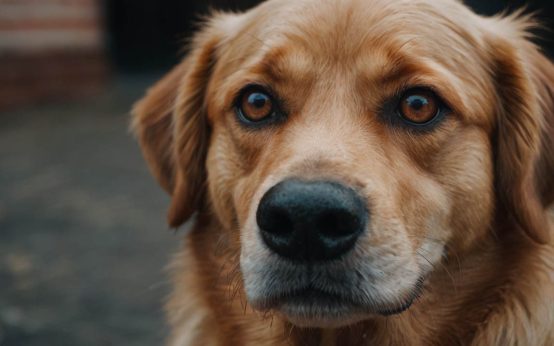Dog Anxiety Symptoms: A Complete Guide to Understanding Your Dog’s Stress Signals
Does your dog start to tremble at the first rumble of thunder? Do they pant and pace relentlessly when you prepare to leave the house? These behaviors are more than just quirks; they are often clear dog anxiety symptoms. Learning to read these signals is the first and most critical step in helping your furry friend find peace.
Let’s talk about a man named David and his loyal Boxer, Winston. David noticed that Winston, who was normally a confident and happy dog, started to change. He’d begin panting heavily during car rides and would stick to David’s side like glue whenever visitors came over. At first, David dismissed it as odd behavior. But as he learned more about dog anxiety symptoms, he realized Winston wasn’t being strange—he was silently screaming for help.
This guide is for every owner like David who has a gut feeling that something is wrong but can’t quite put their finger on it. We will decode the full spectrum of dog anxiety symptoms, from the obvious to the incredibly subtle. Understanding this language of stress is the key to unlocking a happier, more confident life for your dog.
What Are Dog Anxiety Symptoms? More Than Just Fear
It’s crucial to understand that anxiety is different from fear. Fear is a rational response to a present threat (like a big, scary dog running towards them). Anxiety, on the other hand, is the anticipation of a future threat, whether it’s real or imagined. This state of constant worry manifests as a wide range of dog anxiety symptoms.
A 2020 study in Frontiers in Veterinary Science revealed a startling statistic: nearly 75% of dogs exhibit at least one anxiety-related behavior. This isn’t a rare problem; it’s a silent epidemic. Recognizing the symptoms is your first line of defense.

The Obvious Dog Anxiety Symptoms: The Red Flags
These are the big, loud signals that even a casual observer might notice. If you’re seeing these, your dog’s anxiety is already at a high level.
Destructive Behavior as a Symptom of Dog Anxiety
This isn’t just random chewing. Anxiety-driven destruction is often highly focused.
- Exit Points: Frantic scratching, chewing, and digging at doors, windows, and crate bars. This is a classic sign of separation anxiety, as the dog is desperately trying to escape and find you.
- Self-Destruction: In extreme cases, dogs may chew on their own paws or tail, leading to lick granulomas (sore, inflamed skin lesions).
Excessive Vocalization: The Sound of Dog Anxiety
A dog’s barks and whines can tell a story.
- Persistent Barking or Howling: This is common in separation anxiety. The vocalization starts soon after you leave and continues for an extended period. Your neighbors are often the first to report this dog anxiety symptom.
- Whining and Crying: A high-pitched, distressed whine is different from a “I want a treat” whine. It’s a clear signal of emotional distress.
Physiological Dog Anxiety Symptoms: The Body’s Panic Response
Anxiety triggers a “fight or flight” response, leading to clear physical signs.
- Trembling or Shaking: Uncontrollable shaking when the dog is not cold.
- Excessive Panting: Rapid, shallow breathing when it’s not hot and the dog hasn’t been exercising.
- Excessive Drooling (Hypersalivation): You might find pools of drool after leaving your dog alone or during a thunderstorm.
The Subtle Dog Anxiety Symptoms: The Whispers of Stress
Here’s the thing: most dogs don’t go from zero to a full-blown panic attack. They exhibit a series of much more subtle dog anxiety symptoms first. Learning to spot these “whispers” allows you to intervene before the anxiety escalates. These are the signs that truly make you a dog behavior detective.
Body Language: The Silent Dog Anxiety Symptoms
Your dog’s posture speaks volumes.
- Pacing and Restlessness: An inability to settle down and relax. They may walk in circles or pace back and forth along a specific path.
- Yawning, Lip Licking, and “Whale Eye”: These are classic calming signals. A dog will yawn (when not tired) or lick their lips repeatedly when they are stressed. “Whale eye” is when they show the whites of their eyes in a worried expression.
- Tucked Tail and Pinned Ears: A low or tucked tail and ears pulled back flat against the head are universal signs of fear and anxiety.
- Cowering or Lowered Body Posture: A dog trying to make themselves smaller is a dog trying to appear as less of a threat, which stems from fear.
Behavioral Changes: The Shifts in Routine
Sometimes, the most telling dog anxiety symptoms are changes in your dog’s normal behavior.
- Hiding or Clinginess: Suddenly, your independent dog might refuse to leave your side (“Velcro dog”) or may start hiding behind furniture or in closets during a trigger event.
- Avoidance: Actively avoiding certain places or situations. For example, a dog who suddenly refuses to go into the room with the crate.
- Hypervigilance: Being constantly on alert, with a stiff body, unable to relax.
- Changes in Appetite: A sudden loss of interest in food can be a significant indicator of stress and anxiety.
Context is Key: Situational Dog Anxiety Symptoms
A dog anxiety symptom rarely occurs in a vacuum. The context tells you the “why” behind the “what.”
Separation Anxiety Symptoms
These symptoms occur only when the dog is left alone or separated from their primary person. This is the key diagnostic feature. You might set up a camera and see a perfectly calm dog transform into a panicked mess the moment your car pulls out of the driveway.
Noise Phobia Symptoms
These dog anxiety symptoms are tied directly to a specific sound.
- Thunderstorms: Many dogs are sensitive to the change in barometric pressure, the wind, the rain, and the sound of thunder. They may start showing anxiety well before the storm even hits.
- Fireworks: The unpredictable, loud bangs are a common trigger for severe panic.
Social and Environmental Anxiety Symptoms
These appear in specific situations.
- Vet Visits: Trembling, panting, and refusing to walk into the clinic.
- Car Rides: Excessive drooling, whining, and restlessness.
- Visitors or Strangers: Cowering, hiding, or even low growling when new people enter the home.
Why You Must Recognize Dog Anxiety Symptoms
Ignoring these symptoms is not an option. Chronic anxiety is not just a behavioral issue; it’s a serious welfare and medical concern. The constant flood of stress hormones like cortisol can have long-term effects on your dog’s physical health, including a weakened immune system and gastrointestinal problems.
By learning to spot the early, subtle dog anxiety symptoms, you can intervene before the problem becomes severe. You can provide comfort and start a management plan that prevents their fear from spiraling out of control.

A Case Study in Recognizing Dog Anxiety Symptoms
Let’s go back to David and Winston. David started a “symptom journal.” He noted down every time he saw Winston panting, pacing, or becoming clingy. He quickly found a pattern: it happened during car rides and whenever his friend Mark, who had a very deep voice, came over.
Armed with this knowledge, David realized he was dealing with situational anxiety. He wasn’t just seeing “quirks”; he was seeing clear dog anxiety symptoms. This understanding was the first step in creating a plan. He started counter-conditioning for car rides (giving Winston high-value treats just for being near the car) and asked Mark to toss Winston treats whenever he visited, without making direct eye contact at first. It was a slow process, but by recognizing the symptoms, David was able to address the root cause.
FAQ: Your Questions About Dog Anxiety Symptoms
Q: Can dog anxiety symptoms come on suddenly?
A: Yes. A single traumatic event (like a severe thunderstorm or a bad experience at the dog park) can trigger the onset of anxiety. Sudden behavioral changes can also be linked to a medical issue, which is why a vet visit is always the first step.
Q: Are some breeds more prone to dog anxiety symptoms?
A: While any dog can have anxiety, some herding breeds (like Border Collies and German Shepherds) and companion breeds can be more genetically predisposed to it. However, a dog’s individual temperament and life experiences are much bigger factors.
Q: My dog licks their paws a lot. Is this a dog anxiety symptom?
A: It can be. Excessive, compulsive licking (often leading to “lick granulomas”) can be a self-soothing behavior related to anxiety or boredom. However, it can also be a sign of allergies or skin irritation, so a vet check is needed to rule out medical causes.
Q: Can dog anxiety symptoms be a sign of a medical problem?
A: Absolutely. This is critically important. Pain is a major cause of behavioral changes. A dog with arthritis might suddenly become anxious about being touched or going on walks. Thyroid conditions can also cause anxiety. Always rule out a medical cause with your veterinarian.
Conclusion: Becoming Your Dog’s Best Advocate
Learning to read dog anxiety symptoms is like learning a new language—your dog’s language of stress. It transforms you from a confused owner into a compassionate and effective advocate for their well-being. By recognizing the difference between a big, obvious red flag and the quiet whispers of early anxiety, you gain the power to act.
You now have the knowledge to see the lip licks, the yawns, the tucked tail, and the pacing for what they are: a plea for help. You understand that destructive behavior isn’t malice, but panic. This understanding is the foundation upon which all successful training and treatment are built.
Your dog is talking to you. Are you ready to listen? Your task now is to become an observer. Watch your dog during calm times and during potentially stressful times. Start your own “symptom journal” just like David did. Note what you see and the context in which it happens. This simple act of observation is the most powerful first step you can take toward helping your anxious dog find the calm and confidence they deserve.



 Dog Anxiety Symptoms: Complete Guide
Dog Anxiety Symptoms: Complete Guide